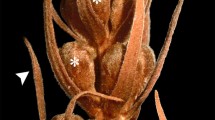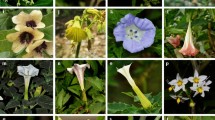Abstract
Most Euphorbiaceae are insect pollinated, but in Acalyphoideae a considerable number of species are wind pollinated and generally have inconspicuous monochlamydeous flowers with red styles and multifid or laciniate stigmata. Alchornea is within the basal alchorneoid clade, and its flowers are more conspicuous in the group. The aim of this study was to investigate the ontogeny, anatomy and vasculature of flowers of Alchornea sidifolia Müll. Arg., species from the Alchorneoids clade, a basal clade sister of the “core acalyphoid,” in order to find structural aspects related to wind pollination. Flowers and buds of A. sidifolia were embedded in Paraplast and sectioned with a rotary microtome for analysis under light microscopy. SEM was performed for additional structural and ontogenetic data. Alchornea sidifolia is dioecious and has morphologically and functionally unisexual flowers which only share a monochlamydeous, tetramerous perianth, organized in a single whorl of sepals. In the male flower, calyx begins as a ring on the floral meristem in a congenital connation, but in the female one, the calyx has a late synsepaly. Pistillodes and staminodes are absent in the male and female flowers, respectively. The filaments of the stamens are connate at the base for a short extant and free toward the apex. The gynoecium is syncarpous, and the ovary is mostly synascidiate with a short symplicate zone and two long stigmata. Our results highlight the development of features of the inflorescence and flowers of A. sidifolia which in comparison with insect-pollinated Euphorbiaceae display a set of features which are typically associated in many other unrelated angiosperm lineages with the evolution of wind pollination, such as dioecy, production of a higher number of flowers in the male inflorescences than the female inflorescences, unisexual flowers with reduced perianth and no nectaries, male flowers with a variable number of stamens and female flowers with extensive stigmatic receptive surface. We also discuss the presence of two carpels in Alchornea, when most Euphorbiaceae and many other Malpighiales have three, and its relationship with the wind pollination.







Similar content being viewed by others
References
Apg II (2003) An update of the Angiosperm Phylogeny Group classification for the orders and families of flowering plants: APG II. Bot J Linn Soc 141:399–436
Apg IV (2016) An update of the Angiosperm Phylogeny Group classification for the orders and families of the flowering plants: APG IV. Bot J Linn Soc 181:1–20
Araújo LDA, Leal AS, Quirino AGM (2012) Fenologia e biologia floral da urtiga cansanção (Cnidoscolus urens L., Euphorbiaceae). Rev Bras Biocienc 10:140–146
Bhanwra RK (1987) Embryology of Euphorbia maddeni and Euphorbia nivulia. Curr Sci 56:1062–1064
Bianchini M, Pacini E (1996) Explosive anther dehiscence in Ricinus communis L. involves cell wall modification and relative humidity. Int J Plant Sci 157:739–745
Bullock SH (1994) Wind pollination of neotropical dioecious trees. Biotropica 26:172–179
Calaça PSST, Vieira MF (2012) Biologia do pseudanto de Dalechampia aff. triphylla Lam. (Euphorbiaceae) e sua polinização por abelhas (Apidae, Meliponina). Rev Bras Biocienc 10:303–308
Cruden RW (2000) Pollen grains: why so many? Plant Syst Evol 222:143–165
Faegri K, Van Der Pijl L (1979) Principles of pollination ecology. Pergamon Press, London
Gerlach D (1984) Botanische Microtechnik. Georg Thieme, Stuttgart
Johansen DA (1940) Plant Microtechnique. McGraw-Hill, New York
Lewis WH (1986) Airborne pollen of the Neotropics. Grana 25:75–83
Lillie RD (1965) Histopathologic technic and practical histochemistry. McGraw-Hill, New York
Puri V (1951) The role of floral anatomy in the solution of morphological problems. Bot Rev 17:471–553
Radcliffe-Smith A (2001) Genera euphorbiacearum. Royal Botanic Gardens, Kew
Rizzardo RAG, Milfont MO, Silva SEM, Freitas BM (2012) Apis mellifera pollination improves agronomic productivity of anemophilous castor bean (Ricinus communis). An Acad Bras Cienc 84:1137–1145
Santos RF, Caruso ABR (2015) Sinopse da tribo Alchorneae (Euphorbiaceae) no estado de São Paulo, Brasil. Hoehnea 42:165–170
Secco RS (2004) Alchorneae (Euphorbiaceae) (Alchornea, Aparisthmium e Conceveiba). Flora Neotrop 93:1–194
Secco RS, Guilietti AM (2004) Sinopse das espécies de Alchornea (Euphorbiaceae, Acalyphoideae) na Argentina. Darwiniana 42:315–331
Stebbins GL (1951) Natural selection and the differentiation of the angiosperms families. Evolution 5:299–324
Stebbins GL (1970) Adaptive radiation of reproductive characteristics in angiosperms. I: pollination mechanisms. Ann Rev Ecol Syst 1:307–326
Tokuoka T, Tobe H (2003) Ovules and seeds in Acalyphoideae (Euphorbiaceae): Structure and systematic implications. J Plant Res 116:355–380
Van Ee BW, Riina R, Berry PE (2011) A revised infrageneric classification and molecular phylogeny of New World Croton (Euphorbiaceae). Taxon 60:791–823
Van Welzen PC, Bulalacao LJ (2007) The genus Alchornea (Euphorbiaceae) in the Malay Archipelago and Thailand. Syst Bot 32:803–818
Webster GL (1994a) Classification of the Euphorbiaceae. Ann Mo Bot Gard 81:3–32
Webster GL (1994b) Synopsis of the genera and suprageneric taxa of Euphorbiaceae. Ann Mo Bot Gard 81:33–144
Webster GL (2014) Euphorbiaceae. In: Kubitzki K (ed) Flowering plants. Eudicots. The families and genera of vascular plants, vol 11. Springer, Berlin, Heidelberg
Wurdack KJ, Hoffmann P, Chase MW (2005) Molecular phylogenetic analysis of uniovulate Euphorbiaceae (Euphorbiaceae sensu stricto) using plastid rbcL and trnL-F DNA sequences. Am J Bot 92:1397–1420
Acknowledgements
This work was supported by FAPESP—Fundação de Amparo à Pesquisa do Estado de São Paulo (Grant No. 2013/10518-7), CAPES—Coordenação de Aperfeiçoamento de Pessoal de Nível Superior (Grant No. 001) and CNPq—Conselho Nacional de Desenvolvimento Científico e Tecnológico (Grant No. 305633/2015-5).
Author information
Authors and Affiliations
Contributions
TSSG and DD conceived and designed the work; TSSG performed the experiments; and TSSG, IC and DD analyzed the data and wrote the paper.
Corresponding author
Ethics declarations
Conflict of interest
The authors declare that they have no conflict of interest.
Additional information
Publisher's Note
Springer Nature remains neutral with regard to jurisdictional claims in published maps and institutional affiliations.
Rights and permissions
About this article
Cite this article
Gama, T.S.S., Cordeiro, I. & Demarco, D. Floral structure and development in Alchornea sidifolia (Acalyphoideae) and the evolution of wind pollination in Euphorbiaceae. Braz. J. Bot 42, 307–317 (2019). https://doi.org/10.1007/s40415-019-00535-0
Received:
Accepted:
Published:
Issue Date:
DOI: https://doi.org/10.1007/s40415-019-00535-0




